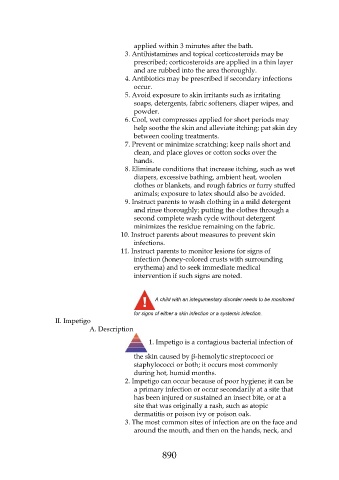Page 890 - Saunders Comprehensive Review For NCLEX-RN
P. 890
applied within 3 minutes after the bath.
3. Antihistamines and topical corticosteroids may be
prescribed; corticosteroids are applied in a thin layer
and are rubbed into the area thoroughly.
4. Antibiotics may be prescribed if secondary infections
occur.
5. Avoid exposure to skin irritants such as irritating
soaps, detergents, fabric softeners, diaper wipes, and
powder.
6. Cool, wet compresses applied for short periods may
help soothe the skin and alleviate itching; pat skin dry
between cooling treatments.
7. Prevent or minimize scratching; keep nails short and
clean, and place gloves or cotton socks over the
hands.
8. Eliminate conditions that increase itching, such as wet
diapers, excessive bathing, ambient heat, woolen
clothes or blankets, and rough fabrics or furry stuffed
animals; exposure to latex should also be avoided.
9. Instruct parents to wash clothing in a mild detergent
and rinse thoroughly; putting the clothes through a
second complete wash cycle without detergent
minimizes the residue remaining on the fabric.
10. Instruct parents about measures to prevent skin
infections.
11. Instruct parents to monitor lesions for signs of
infection (honey-colored crusts with surrounding
erythema) and to seek immediate medical
intervention if such signs are noted.
A child with an integumentary disorder needs to be monitored
for signs of either a skin infection or a systemic infection.
II. Impetigo
A. Description
1. Impetigo is a contagious bacterial infection of
the skin caused by β-hemolytic streptococci or
staphylococci or both; it occurs most commonly
during hot, humid months.
2. Impetigo can occur because of poor hygiene; it can be
a primary infection or occur secondarily at a site that
has been injured or sustained an insect bite, or at a
site that was originally a rash, such as atopic
dermatitis or poison ivy or poison oak.
3. The most common sites of infection are on the face and
around the mouth, and then on the hands, neck, and
890

